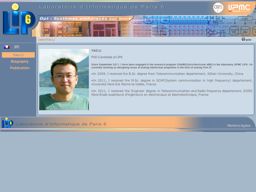Direction de recherche : Marie-Minerve LOUËRAT
Co-encadrement : ISKANDER Ramy
Proposition d'extension à SystemC-AMS pour la modélisation, la conception et la vérification de systèmes AMS
Parmi les produits électroniques de l'industrie des semiconducteurs, les applications mixtes numériques-analogiques (AMS) représentent une part de marché à forte croissance. Le principal problème pour la conception de systèmes AMS est l'absence de flot de conception standard, puisque les blocs AMS ne peuvent pas être synthétisés de façon systématique à partir d'une spécification de haut niveau en l'absence d'information au niveau transistor. Par ailleurs, il est très difficile de modéliser les caractéristiques au niveau transistor dans des descriptions comportementales de plus haut niveau (système).
Face à ces défis, nous proposons une plateforme de modélisation, de dimensionnement et de vérification unifiée. La plate-forme repose sur une méthode de dimensionnement ascendant des blocs analogiques et une approche de simulation descendante depuis le système jusqu'aux transistors. Les différents niveaux d'abstraction envisagés sont décrits grâce aux langages C/C ++ et SystemC-AMS. En outre, nous expliquons comment UVM-SystemC-AMS développé dans le cadre du projet européen FP7 VERDI, fournit une méthode pour la vérification des systèmes AMS avec des interactions HW / SW.
Nous appliquons ces méthodes à deux circuits. Le premier est un circuit de conversion analogique-numérique pipeline à 3 étages et 6 bits. Il présente une vue hiérarchique du processus de conception. Le second est un sous-système analogique d'un système implantable de télémétrie, qui inclut une boucle de rétroaction.
Soutenance : 17/06/2015
Membres du jury :
M. Christoph GRIMM, Professeur, Kaiserslautern University of Technology [Rapporteur]M. Ian O’CONNOR, Professeur, Ecole Centrale de Lyon [Rapporteur]
M. Ahcene BOUNCEUR, Maitre de Conférence HDR, Université de Bretagne Occidentale
M. Daniel SAIAS, Industrie, ASYGN
M. Hervé GUEGAN, Industrie, ASELTA
M. Dimitri GALAYKO, Maître de Conférences HDR, UPMC-LIP6
Me. Marie-Minerve LOUERAT, CNRS, HDR, UPMC-LIP6
M. Ramy Iskander, Maître de Conférence, HDR, UPMC-LIP6
Date de départ : 30/06/2015
Publications 2012-2015
-
2015
- Y. Li : “Extending SystemC-AMS standard to Modeling, Design and Verification of Mixed-signal Systems ”, soutenance de thèse, soutenance 17/06/2015, direction de recherche Louërat, Marie-Minerve, co-encadrement : Iskander, Ramy (2015)
- Y. Li, Zh. Wang, F. Pêcheux, M.‑M. Louërat, M. Barnasconi, Th. Vörtler, K. Einwich : “AMS System-level exploration and verification using UVM in SystemC and SystemC AMS”, 2nd Workshop Design Automation for Understanding Hardware Designs (DUHDe), Grenoble, France (2015)
- A. Malak, Y. Li, R. Iskander, F. Durbin, F. Javid, M.‑M. Louërat, A. Tissot, J.‑M. Guebhard : “Fast multidimensional optimization of analog circuits initiated by monodimensional global Peano explorations”, Integration, the VLSI Journal, vol. 48, pp. 198-212, (Elsevier) (2015)
- Y. Li, H. Zou, Y. Moursy, R. Iskander, R. Sobot, M.‑M. Louërat : “Optimization and Co-Simulation of an Implantable Telemetry System by Linking System Models to Nonlinear Circuits”, chapter in Computational Intelligence in Analog an Mixed-Signal (AMS) and Radio-Frequency (RF) Circuit Design, pp. 83-113, (Springer) (2015)
-
2014
- Th. Vörtler, Th. Klotz, K. Einwich, Y. Li, Zh. Wang, M.‑M. Louërat, J.‑P. Chaput, F. Pêcheux, R. Iskander, M. Barnasconi : “Enriching UVM in SystemC with AMS extensions for randomization and coverage”, Design and Verification Conference and Exhibition (DVCON Europe), Munich, Germany (2014)
- R. Lucas, E. Vaumorin, Ph. Cuenot, Y. Li, Zh. Wang, M.‑M. Louërat, J.‑P. Chaput, F. Pêcheux, R. Iskander, M. Barnasconi, Th. Vörtler, K. Einwich : “Generation of UVM compliant Test Benches for Automotive Systems using IP-XACT with UVM-SystemC and SystemC AMS extensions”, Design and Verification Conference and Exhibition (DVCON Europe), Munich, Germany (2014)
- Y. Li, R. Iskander, M.‑M. Louërat : “Modeling, Design and Verification Platform using SystemC AMS”, 15th International Symposium on Quality Electronic Design, ISQED 2014, Santa Clara, CA, United States, pp. 39-46, (IEEE) (2014)
- Y. Li, Zh. Wang, M.‑M. Louërat, F. Pêcheux, R. Iskander, Ph. Cuenot, M. Barnasconi, Th. Vörtler, K. Einwich : “Virtual Prototyping, Verification and Validation Framework for Automotive Using SystemC, SystemC-AMS and SystemC-UVM”, Embedded Real Time Software and Systems (ERTS2), Toulouse, France, pp. 1-10 (2014)
- Y. Li, R. Iskander, F. Javid, M.‑M. Louërat : “A Design and Verification Methodology for Mixed-Signal Systems Using SystemC-AMS”, chapter in Models, Methods, and Tools for Complex Chip Design, vol. 265, Lecture Notes in Electrical Engineering, pp. 89-108, (Springer) (2014)
-
2012
- Y. Li, R. Iskander, F. Javid, M.‑M. Louërat : “A Unified Platform for Design and Verification of Mixed-Signal Systems Based on SystemC-AMS”, Forum on specification & Design Languages, FDL 2012, Vienna, Austria, pp. 75-82 (2012)
- Y. Li, R. Iskander, F. Javid, M.‑M. Louërat : “An Interface between System-level and Circuit-level for Design of Mixed-Signal Systems”, Colloque GDR SOC-SIP, Paris, France, pp. 1-2 (2012)
